#subshrub
Text


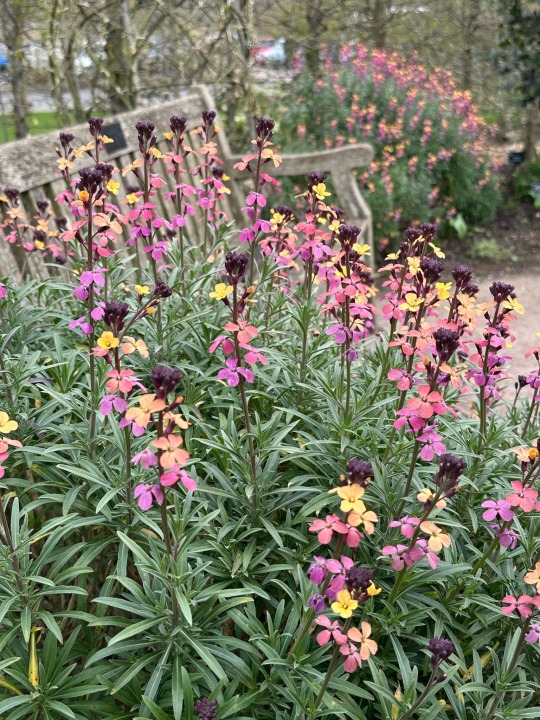

Plant of the Day
Wednesday 17 April 2024
The sub-shrub perennial Erysimum mutabile (changeable wall-flower) produces a woody base covered with slender, lax stems that produce flowers in yellow, pink and purple. This species will thrive on a well drained location for a few years but is easily replaced by growing further plants from cuttings.
Jill Raggett
#Erysimum#perennial wallflower#changeable wall-flower#yellow flowers#pink flowers#subshrub#dry garden#plants#horticulture#gardens#garden#essex#gravel garden#RHS Hyde Hall
182 notes
·
View notes
Text
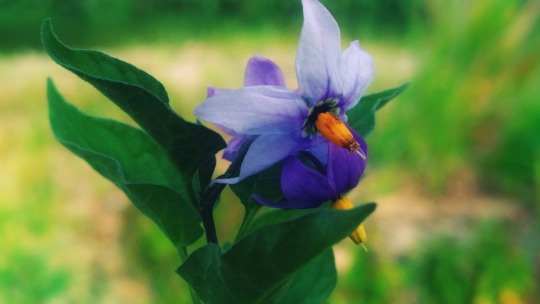

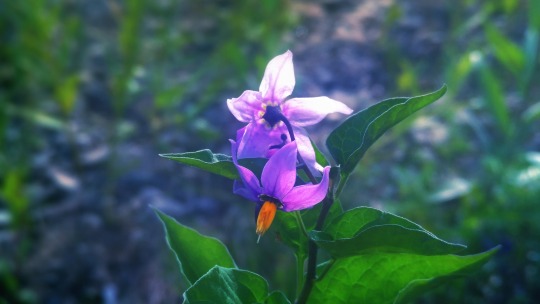
Нежные фиолетовые цветы Паслёна сладко-горького (лат. Solánum dulcamára ) .
Delicate purple flowers of the bittersweet nightshade (lat. Solánum dulcamára).
#русский tumblr#россия#природа#зеленая природа#загородом#поля#полукустарник#паслен#цветы#солнечные лучи#мои фото#russia#nature photography#outdoors#beauty of nature#fields#plants#subshrub#flower#nightshade#sun rays#my photos#original photography#photographers on tumblr
306 notes
·
View notes
Photo

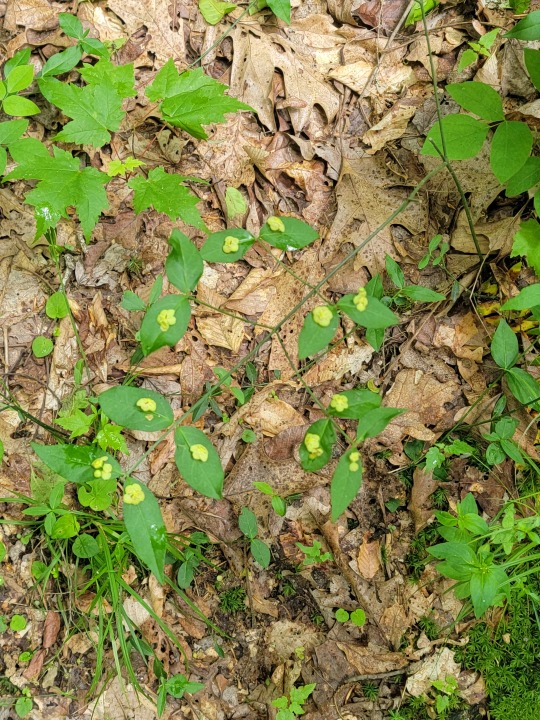
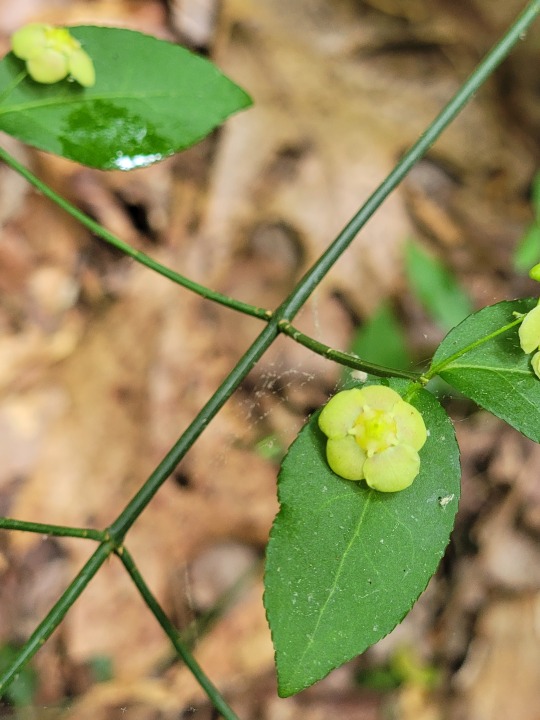
Euonymus americanus
one of my favorite subshrubs, also known as spikey exploding strawberry or hearts a’ burstin’ in Appalachia. Great species for shade gardens and bird starvation food.
51 notes
·
View notes
Photo
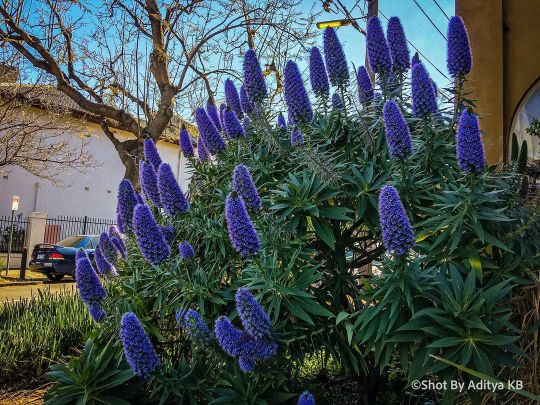
#echiumcandicans #the #pride #of #Madeira #species #of #flowering #plant #family #Boraginaceae #native #herbaceous #perennial #subshrub #germination #rosette #leaves #6splus (at Melbourne, Victoria, Australia) https://www.instagram.com/p/CegCUfuFhwX/?igshid=NGJjMDIxMWI=
#echiumcandicans#the#pride#of#madeira#species#flowering#plant#family#boraginaceae#native#herbaceous#perennial#subshrub#germination#rosette#leaves#6splus
0 notes
Photo

You deserve September flowers. Lespedeza’Gibraltar’ #lespedeza #fallflowers #pinkflowers #subshrubs https://www.instagram.com/p/Cid7kApOsRr/?igshid=NGJjMDIxMWI=
0 notes
Text
Sage
Salvia officinalis
Known as: Common sage, green sage, garden sage, meadow sage, culinary sage & true sage
Related plants: A member of the of the mint family Lamiaceae that includes plants such as basil, mint, rosemary, sage, savory, marjoram, oregano, hyssop, thyme, lavender & perilla as well as catnip, salvia, bee balm, wild dagga & oriental motherwort.
Parts used: Leaves & stems
Habitat and cultivation: This evergreen subshrub is native to the Mediterranean region with it's mild to cool, rainy winters & warm to hot, dry summers.
Plant type: Perennial
Region: Zone 5-8 your sage will grow as a hardy perennial. However in the humid climates of zones 9 & farther south, sage is usually an annual, as it does not easily tolerate summer heat & humidity.
Harvest: Harvest lightly in the first year to ensure the plant grows fully. After the first year, be sure to leave a few stalks so that the plant can rejuvenate in the future & If fully established, one plant can be harvested up to three times in one season.
Planting tips: Plant in full sun & plants should be two feet apart. Sage should be planted in well draining soil like a sandy or loamy soil with good drainage. Wet soils can cause rot and be fatal to the plant. The easiest and best way to start sage is from a small plant, but you can also sow seeds up to two weeks before the last frost date.
Medicinal information: Taking sage by mouth seems to improve memory and thinking skills in healthy adults & taking it for four weeks can improve menopause symptoms. One study found that drinking tea made from sage both raised antioxidant defenses and lowered LDL or “bad” cholesterol. It also could be used for pain after surgery, lung cancer, sore throat, sunburn, and many other conditions. Sage leaves have been used in traditional medicine as a treatment for diabetes.
Cautions: Sage is possibly unsafe when taken in high doses or for a long time due to a chemical called thujone. Too much thujone can cause seizures and damage the liver and nervous system. Thujone can also bring on a menstrual period, which could cause a miscarriage so taking sage during pregnancy is not advised. It may also reduce milk production while chest feeding.
Magickal properties
Gender: Masculine
Planet: Jupiter
Element: Air
Deities: Chiron, Consus, Jupiter, Obatala & Zeus
Magickal uses:
• Use the leaves for tea for communion of Jupiter or in any workings involved with the planet & grounding
• Burn to find clarity & wisdom while asking difficult questions
• Write a wish on Sage leaf and burn it to release your intention
• Place a Sage leaf in your wallet to attract money
• Include in feminine fertility spells to boost your chances of success
• Add Sage oil incense or herbs to any spell to temper the results with wisdom
• Burn during a funeral & memorial to facilitate healthy grief and bonding with the spirits of those who passed on
• Use spells to alleviate grief & steady emotions
• Put in a satchet to carry from protection from negative energies & influences
• Burn to cleanse your home, clear negative energies & increase your intuition
• Rub sage on your forehead before divination to increase the accuracy of your results
• Pick twelve leaves at midnight on Christmas Eve to see a vision of your future husband(without damaging the bush)
• Write your desire on a sage leafe & place it under your pillow for three days. If you dream of your desire, it will soon materialize. If not, bury the sage.

#herb of the week#sage#herbalism#green sage#witchblr#wiccablr#paganblr#witch tumblr#witches of tumblr#witch community#witchcraft#book of shadows#grimoire#spellbook#spells#spellcraft#green witchery#green witch#magical herbs#beginner witch#baby witch#witch tips#baby witch tips#beginner witch tips#witch#spellwork#witchy things#GreenWitchcrafts#correspondence#witchcore
128 notes
·
View notes
Note
honestly would love to hear more about twinflower if you felt like sharing? :)
I have been drafting this ask response on and off for over a week because I want everyone to love twinflower as much as I do thank you for your patience uh I mean yes! I do feel like sharing! thank you for enabling me! make yourself a cuppa and get comfy. it's Gloam's Natural History Hour, and here is everything you should love about the twinflower
Let us begin with the Latin name: Linnaea borealis. But first, it was Campanula serpyllifolia. Let me explain.
Twinflower is a small and unremarkable evergreen plant that nonetheless captured the heart of one of the world's most influential scientists in the eighteenth century. Species Plantarum is best-known for containing the first consistent use of binomial nomenclature (genus and species), but it was also there that Carl Linnaeus described twinflower for the first time.
It is a creeping subshrub that grows along the ground, with green and glossy shallow-toothed oval leaves about the size of dimes. Blooms come from delicate hairy stems that have unfolded themselves to the comparatively towering height of two or so inches above the ground. They are pinkish-white, nodding, and look like the sort of thing you'd imagine a fairy lives in. As you might suspect from the name, they grow in pairs. Some three centuries after Linnaeus first described it, one Mark C. in the comments of a 2013 blog post described the fragrance as "a delight to the most jaded sniffer".
In portraits, he is often found holding it. (Linnaeus, not Mark C.) He dearly loved it. But he could not name twinflower after himself: at first, it was classified in a different genus, and besides, it was poor taste. What's a guy to do?
Become acquainted with a wealthy Dutch botanist, Gronovius, son not of preachers and peasants but classical scholars, who would name it for him in his honour. Naturally. In gratitude, and advocacy for such acts of commemorative botanical naming, Linnaeus wrote in Critica Botanica:
It is commonly believed that the name of a plant which is derived from that of a botanist shows no connection between the two...[but]...Linnaea was named by the celebrated Gronovius and is a plant of Lapland, lowly, insignificant, disregarded, flowering but for a brief space — after Linnaeus who resembles it.
He would go on, of course, to receive fanmail from Rousseau. Contemporary Goethe would later write: "With the exception of Shakespeare and Spinoza, I know no one among the no longer living who has influenced me more strongly."
Lowly Linnaeus himself chose borealis, for Boreas, the Greek god of the north wind; and indeed it grows where the north wind blows, in a great circumboreal ring around the globe, from semi-shaded woodlands in southern British Columbia (hello), to tundra and taiga in Sweden and Siberia. You can find the same blooms in China and Poland and Minnesota. It's as old as glaciers. In Poland and other European countries it is in fact protected as glacial relict, and you can find it isolated at high elevations far south of its range, where it was left behind in the Pleistocene.
And now it is Linnaea borealis.
When Linnaeus was ennobled twenty years later for his services to botany, zoology, and medicine, he put the twinflower on his coat of arms. Some references use hedging (pun intended) language to describe their relationship: he was 'reported to be fond'. It was 'rumoured to be a favourite.' Bullshit, I say. He was in love. Anyone can see it.
One final etymological point of interest: his surname is itself borrowed from nature. After enrolling in university, his father had to abandon his patronymic last name and create family name. A priest, he created the Latinate Linnæus after linden - the great tree that grew on the family homestead.
And so from Latin and nature sprung the name, and not a generation later, unto Latin and nature it had returned. A name crafted of whole cloth in homage an enormous tree now describes the genus of a plant that tops out at three inches tall and has flowers smaller than your thumbnail.
In spite of this, its uses are myriad. A common name of twinflower in Norwegian, nårislegras, translates to corpse rash grass, for its use in treating skin conditions. It can be made into a tea to take in pregnancy or provide relief of menstrual cramps. Scandinavian folk medicines use it for rheumatism. Humans have made it into teas, tinctures, decoctions, poultices, and even administered its therapeutic properties via smoke inhalation. And then there is its persistent and widespread use in filling our hearts: lending itself century over century and season over season to mankind, to a coat of arms, a poem, a photo, a fond memory—
Ralph Waldo Emerson, in Woodnotes I, says this of twinflower and the man it's named for:
He saw beneath dim aisles, in odorous beds,
The slight Linnaea hang its twin-born heads,
And blessed the monument of the man of flowers,
Which breathes his sweet fame through the northern bowers.
Art is subjective, but I will happily admit I prefer this passage, from Robert of Isle Royale, on the website Minnesota Wildflowers:
My wife and I encountered Linnaea borealis in the last week of June 38 years ago on Isle Royale. We now live in Vilas County in northern Wisconsin and were happy to find a large patch of Twinflowers growing under the sugar maples, balsam fir and hemlock on our property there. This is now very special to us and we await their flowering each June around our anniversary.
A final note. Twinflower requires genetically different individuals to set seed and reproduce sexually. This is known as self-incompatibility. Thus the plants in those isolated spots - old glacial hideouts, or places with fragmented plant populations like Scotland - only reproduce clonally. Let us end with imagining a plant that has not reproduced with another for millennia, but instead carries its line on its own back, and survives by creating itself over and over again, in a genetically identical colony that grows with wet summers and shrinks with dry ones; that briefly blooms every June, lifting its flowers high above itself, a hundred tiny beacons that will be answered only by its own voice; and there, too far for pollination, but a distance you or I could travel in minutes, is its nearest partner, doing the same thing, across an impossible void that looks to us as nothing more than a gap between one part of the woods and the next. Yet it is L. borealis, named for a man named for a tree, that is capable of looking out across generations of humankind walking fragmented pine woodlands and the ghostly southern border of the Laurentide ice sheet, and seeing nothing more than the gap between one seed-set and the next.
Let us end with imagining a tiny plant, and ourselves beside it, loving it for hundreds of years, even smaller.

#asks#botany#plants#twinflower#Linnaea borealis#an essay#that i have put my whole heart into#read it?#or don't but go sit in nature for a bit#and marvel at it all til ur chest hurts with love#that's the takeaway i'm going for here anyway#about me#outside the cabin#my writing
84 notes
·
View notes
Text
I keep hearing from various sources that this Winter's supposed to be a fairly bad one.
I'm ok with losing the Absinthe Wormwood and Mugwort because they're fast growers, if it comes down to it. But the Hyssop was such a slow grower ... I'm wondering if I should just go ahead and dig up the Hyssop, repot it, and bring it in for winter to ensure it keeps- or just leave it and see what comes of it.
Repotting it risks loosing it regardless. But there's still a chance it might keep inground. But I'm still leaning towards repotting it just because it took so dang long for it to even grow the tiny amount that it did and I really don't want to rebuy it next season if I don't really have to because I was able to keep it going, y'know?
Digging almost anything up right before winter, though, is usually such a risky move. Eugh. I'm so conflicted on this one, and I have zero experience with this plant to guide me on it.

ETA: My Husband and I uprooted it and pulled it in tonight, and I'm really glad I did.
I'd checked on everything in the garden before our temps started dropping into the 30's the first time and it was doing ok; about as well as it had been all year- which is to say not great, but at least green. But when we went out today about 90% of it's growth's already died off completely since the temps started doing their switchback* nonsense.
Oklahoma's famous "is it or isn't it" seasonal intermission where it flips back and forth between ~90f and ~30f randomly, and you never know what it's going to be from day to day. Not until it finally decides to get its act together more consistently- which is always a tossup for timing; could be a week of the nonsense, could be 3 months. You literally never know. Just the perks of being in a massive ecological transitional zone.
The plant never got any bigger than my palm throughout the year, despite it supposing to be a semievergreen subshrub that gets quite big- and by this point it should be roughly rivaling my Rosemary in size. But there's only about 4 living stems left on it now, out of the 7 it originally had, and the leaves that are on the remaining ones are shriveled to Antarctica and back. The roots were unhealthy and had significant dieback already, too. Especially compared to some of the healthier plants I dug up alongside it and chucked (because I'm not keeping them).
We'll see if it survives, but it looks kind of grim either way.

ETA 2: For those saying Hyssop "should be hardy to my Zone" ... Yes ... I do know enough to know that it reasonably should be; reasonably speaking, at normal times, in normal seasons, my area shouldn't routinely get cold enough to make it an issue, especially with good Winter protection.
Unfortunately in the last 3 years our Winters have gotten particularly brutal; we've had Ice Storms (a rare phenomenon that only typically occurs about every decade or so, and most frequently in January) occurring twice or more in a season, as early as October. And we're seeing regular temperatures as low as -25f for weeks at a time. We're also getting snow (a phenomenon we don't usually get here that much or for that long, where we mostly just get Sleet- or frozen rain, for those unfamiliar with it- for about a week) more often and in larger quantities than before.
Hyssop is really only cold hardy down to roughly -13f. So even the best Winter protection is not really going to protect Hyssop from those kind of conditions. Especially not in a year when the coming Winter is predicted to be even worse than usual (which includes being even worse than the last 3 pretty bad years that we've already experienced) ... But it's especially not going to protect a palm sized, 1 year old Hyssop plant that's already been struggling all year long to begin with.
Very respectfully and appreciatively: "It should" means absolutely nothing in this circumstance and ultimately doesn't really help me. I'm just going to delete those comments because you're being unhelpful and irrelevant.
#Personal#2023#My Garden#Garden 2023#Verderer#Gardening#Green Witch#Green Witchcraft#Oklahoma#Witchy Gardening#Witches Garden#Witch's Garden#Gardenblr#Plantblr
22 notes
·
View notes
Text
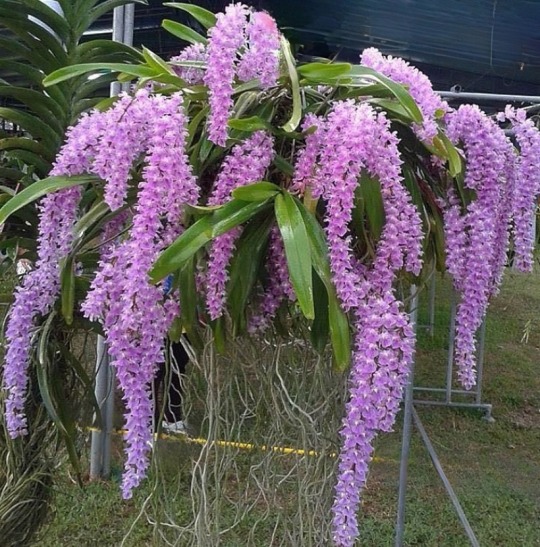
Aerides rosea lodd 🥀🌸
เอื้องกุหลาบแม่เมย 🇹🇭 🇹🇭
Native range of this species is Thailand, E. Himalaya to S. China and Indo-China. It is an epiphytic subshrub and grows primarily in the wet tropical biome, blooms in the spring and summer
16 notes
·
View notes
Text
@karamell-sweetz has enabled me to do this so I'll explain why the Rondo concept CD is called Murasaki.
(I'm using Wikipedia for everything because I'm just some guy that's crazy about this DJ unit, I'm not smart, also this post is super long so I'm not explaining why the songs chosen are those songs even though I want to.)
The kanji used for Murasaki in the song is '茈'. Which can mean Water Chestnut in Chinese and Gromwell in Japanese. I'll be focusing on Gromwells since Water Chestnuts doesn't have very big connections to anything Rondo. Other than the fact that it grows in the water like Crinoids, which are marine creatures (but in muddy water and marshes not the ocean), and that they remain crisp even after being cooked or canned like lotuses.
Now, onto Gromwells! It can refer to two plants that have closely related genera, Lithodora and Lithospermum.
First is Lithodora because I thought this one wouldn't take long. Lithodora is a genus of flowering plants in the family Boraginaceae, native to southwestern Europe, southern Greece, Turkey and Algeria. They are low-growing, evergreen shrubs and subshrubs.
So, another flower I need to bring up are Camellias, the flower that Tsubaki is named after. Camellias are also evergreen shrubs and for some species are low-growing like Lithodora. That's the only connection it has but they also grow nicely under the shade and I'll stop that part before I ramble about a whole other thing. Just know that in Celsius they bring up that the world is dark and cold, but the monster and the person with them -- the singer -- are trapped in that world but still thriving and living, similar to how Camellias can grow even under the shade.
Now, to return to the original point, Lithodora has a species called Lithodora Fruticosa (This is because they're fru--). Which is usually called a shrubby gromwell. It can grow on dry ground and stony hillsides usually on limestones.
Limestones are formed when minerals precipitate out of water containing dissolved calcium. It can take place through both biological and non-biological means, with the biological process being an accumulations of corals and shells in the sea. I bring this up because Crinoids were much more abundant and diverse in the past and apparently some thick limestone beds down underwater during the Paleozoic to Jurassic era are almost entirely made up of disarticulated Crinoid fragments. This is the only connection I found that doesn't sound like I'm grasping straws.
Now, onto the other plant, Lithospermum. I'll talk about two things, so I'll start with Lithospermum purpurocaeruleum, or the purple gromwell. I will be calling this the purple gromwell to avoid confusion between the two.
The purpurocaeruleum part of the name means 'purple and blue', referring to how the buds of purple gromwells look purple-reddish hue and when it fully blooms it becomes a dark blue. The flowering period of these gromwells are April to June, which is spring. Rondo has two songs connecting to spring, which is ARCANA and Celsius, making it connect back to Celsius yet again and making it have another connection to ARCANA. The first connection being the fact that one of the lyrics is 'murasaki no hana', which translates to purple flower.
Now, that's it for the purple one, onto Lithospermum Erythrorhzion or what I'll be calling it in this post, the red gromwell.
It can also be called a purple gromwell (duh), red stoneroot, red-root gromwell and redroot lithospermum.
Red gromwells in China (they're called zǐcǎo if you were curious) are used for herbal medicine with various antiviral and biological activities. In Japan they've been used ever since the Nara period for its herbal medicine and dye properties thank to its root. Like every other way of making purple dye, it's super long and complex which caused them to make a sumptuary law in the Heian period that only people of high-ranking or the Empress and her ladies in waiting can wear clothing with the dye.
The reason why I'm bringing up every time they say red is because the Hiiro part of Hiiro's name literally means 'red color', also because Rondo in their second anniversary outfits are based on high-ranking or important chess pieces.
Aoi and Tsubaki have a clear connection since they're the king and queen pieces respectively, Hiiro is the bishop which makes her important since bishops act as the right-hand man to the king and queen, and Nagisa is the knight, the chess piece might not seem important, but the knight is the only chess piece that can go over other pieces, making it important or 'high-ranking' in the game.
That's the only connections I knew and found so far connecting murasaki to some stuff important to Rondo, if I found any more connections after it drops (looks at prayer remix) then I might make a post about the songs in the album and why they were chosen.
#crow talks#d4dj#d4dj groovy mix#rondo#aoi miyake#tsubaki aoyagi#nagisa tsukimiyama#hiiro yano#please thank karamell-sweetz for enabling me to spit all of this out#im quite glad they did!#i love talking abt them can u tell?#i have more stuff to say but i think i'll save that for another time#im gonna do my assignments and other stuff now! see ya!
3 notes
·
View notes
Text


Plant of the Day
Saturday 27 January 2024
This tender sub-shrub Pelargonium crispum 'Variegatum' (variegated lemon geranium) has an upright habit with rounded, crispy-edged, lemon-scented leaves margined with creamy-white. Plants produce small pale pink flowers in clusters.
Jill Raggett
#pelargonium#variegated lemon geranium#geranium#plants#horticulture#tender#subshrub#variegated#leaves#scented#glasshouse#houseplant
111 notes
·
View notes
Photo


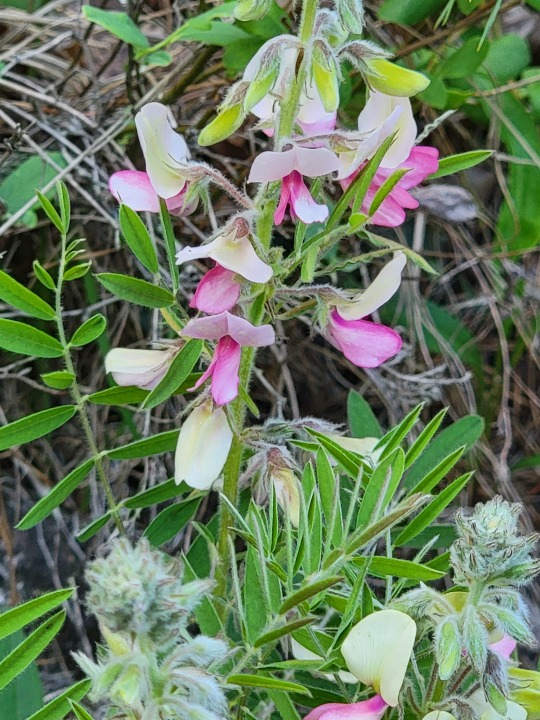
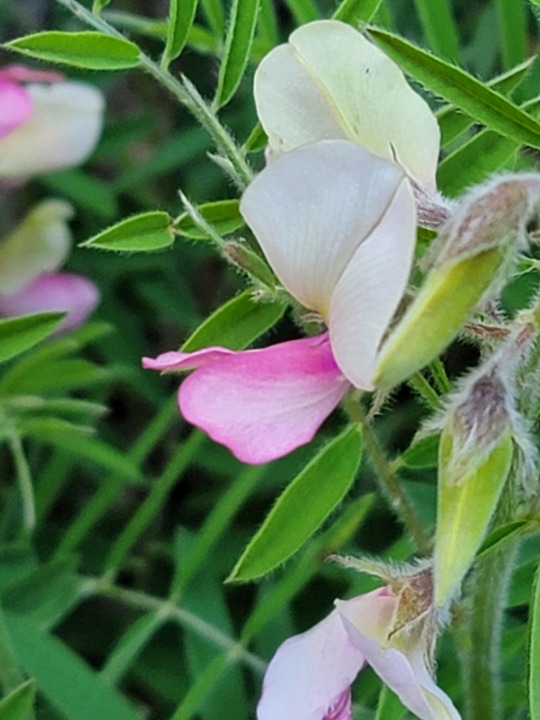
Virginia Goats Rue,
Tephrosia virginiana
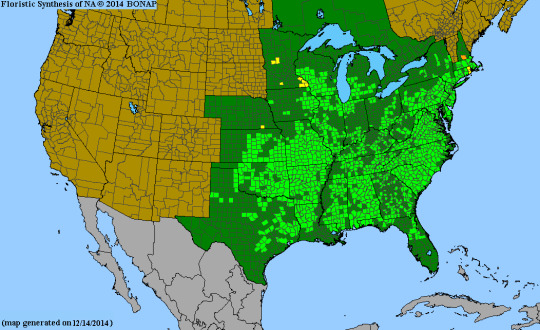
Whenever I see this plant I think acidic nutrient poor soils, ericaceous.
It prefers acidic weathering sand, well drained, in full sun, and often is associated with heavily mycorrhizal dependent environments despite not associating with mycorrhizae. It’s extremely good at nitrogen fixation and cannot take being shaded out. Sandy oak savanna, pine barrens, riolitic gravel barrens, dry prairie with an associated circum acidic ph are ideal locations for this species. Here, at RRG, we see it on a burn ridge, specifically in MG FE rich acidic sandstone in what is classified as an ericaceous heath belt. It is not a forbe despite it’s looks but has a woody basal crown and a very stout woody tap root that branches scarcely into tenuous fibrous roots with root nodules for the nitrogen fixing bacterial units. Some claim that this physiological trait is a caudex or a caudiform structure, though it’s more knobby and less of a thickened mass/base that hasn’t been fully investigated for water storage, instead I think that it’s maybe more likely to produce herbaceous epicormic shoots as a reaction to fire and may more likely be a lignotuber(post fire regenerative woody knobby base) instead of a caudex; either way, this woody habit makes this species a sub shrub and not a forbe. Animals are not likely to graze/ browse on this legume due to slight toxicity; with this said, the rotenone compound is a known icthyotoxic chemical (lethal to fish if made into root powder and used.) While no longer used for fishing due to knowledge of bio-accumulation of toxins, it is being researched for invasive species control. The species reminds me of partridge pea in it’s ground bird dispersed seeds, while we have a true Faboideae sect. species with banner and keel morphology, you’ll notice that it has an exposed/ keel and wing form allowing easy access and buzz pollination more often than most papillionaceous flowers. (senna and partridge peas are primarily buzz pollinated and are in sect. Caesalpinioideae (subfamily of fabaceae)). I see more bumble bees and wasps on this species than any other forbe this time of year ( Late May).
Most Tephrosia are coastal plains species with only one other “wide spread” species (T. spicata)
Though T. onobrychoides does make it in-land due to Oklahoma short grass prairie matrix.
42 notes
·
View notes
Text
Salvia guaranitica Anise- Scented Sage

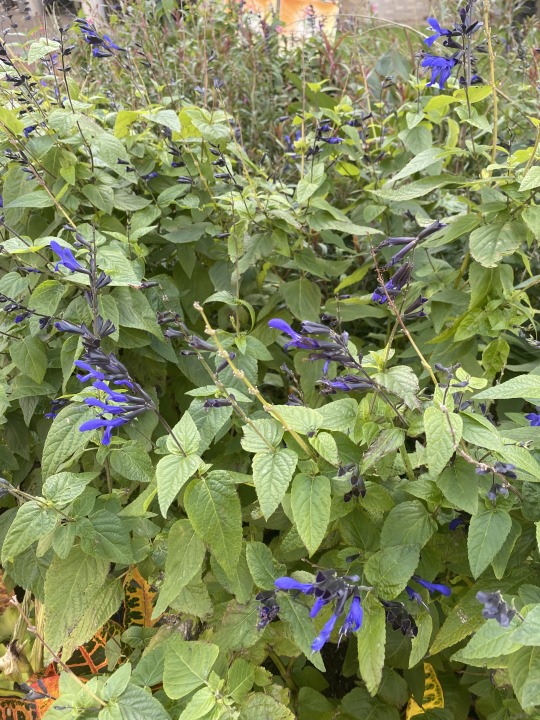
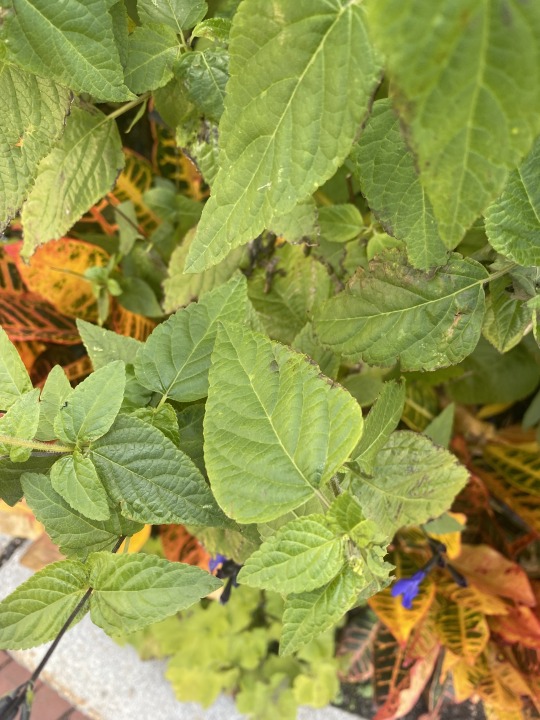


This plant was photographed on Northeastern University's arboretum near the Curry Student Center
Basic Facts
The cold hardiness zones of this plant are zones 8 to 10 and it can bloom from July to frost. It prefers full sun, medium water, and well drained loamy soil. This plant is also a subshrub that can grow 3 to 5' tall. It has 2 inch blue flowers that are two-lipped and tubular
Design
Salvia guaranitica does well in containers and can even be used in beds, borders and cottage gardens. Some cultivars of this plant should be propagated from cuttings and ensured that not too much shade is given. After the last frost date, only then should the plants be set out. Also to encourage more bloom, be sure to deadhead spent flowers.
Bird attraction
This plant does well at attracting pollinators, butterflies, and hummingbirds because of the flowers it produces. Hummingbirds are attracted to nectar, meaning that this is a plant that acts as a food source for birds!
Sources
https://www.missouribotanicalgarden.org/PlantFinder/PlantFinderDetails.aspx?kempercode=c834
https://blogs.massaudubon.org/yourgreatoutdoors/say-hello-to-hummingbirds/
0 notes
Text
Day 30 8.6.23
Marthin picks me up around 10 ish in an Uber with his friend Paola, we go to Alejandro’s apt because he is another friend of M’s and has a car and will drive us up the mountain to the much anticipated trip to Paramo de oceta —-“which means an ecosystem above the continuous forest line yet below the permanent snow-line”
Every day I look at the mountains outside the windows which make up the eastern facing walls of my airbnb. I want to know what it’s like to be inside of the mountain. Now, on the last full day, I will.
It’s misty and rainy and the ground is incredibly wet and slippery and what starts out as black mud and dirt quickly shifts to brown wet clay, then gray, then yellow. The sound shifts too with the squirts in texture -I think of Alejandra in her studio throwing pots and mugs and also the famous brick library built in the shape of a snail—Biblioteca Pública Virgilio Barco—I visited the day before, same architect as Marthin's apt. A mountain and city made of clay.
The environment is otherworldly with the thick mist and filled with lichen and Espeletia, or Frailejon plants which is a type of perennial subshrubs (reminds me of a large pineapple) they are often called “big monks” because they form in clusters and the silhouettes look like cloaked friers on their way to mass—I am very intrigued by this reference because it plays into my interest in natural history and human’s eco-centrism, desire to domesticate the natural world.
The plants have hairy leaves which help them trap water and the center is hollow–to hold all the water. They take forever to grow. They have beautiful yellow flowers. There are also these spiky silver looking succulent like plants that grow from the center outward as well as lots of tiny little purple and red flowers and orange barked wire like trees.
The whole hike is supposed to take about 2 hours, we take about 4 because there is an incredible waterfall to swim in (I hold back because I am already cold and know getting completely wet will put me over the edge) and also because we are taking our time, and taking pictures and there is so much clay and mud so we have to be careful with our footing. After we finish we sit in the pick-nick area and we eat bone broth soup and arepas and sugarcane tea with cheese. We drive back to P’s house for a coffee and then home. A full day.
1 note
·
View note
Text
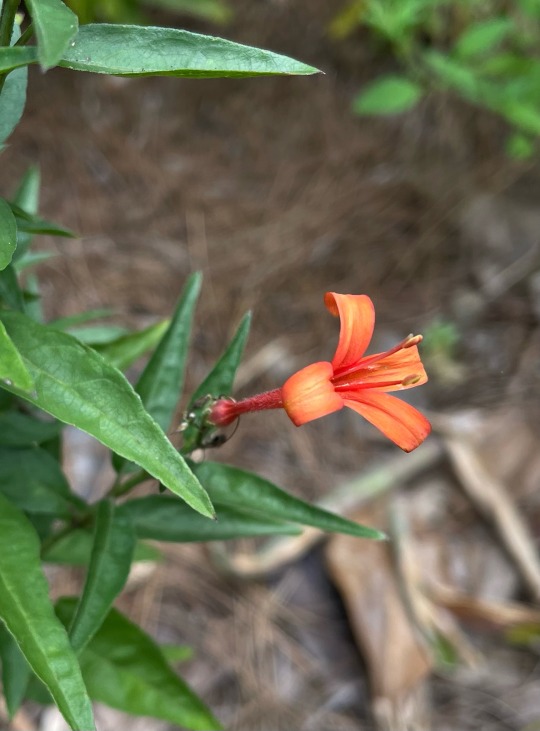
Typical colored form of Anisacanthus wrightii, a hummingbird-pollinated member of the acanthus family from southern TX. I’m really pleased with this species so far; it’s handled a phenomenally shitty bed at work (fill dirt, awful root comp, sloping, parking lot esque radiative heat, years of what I call “bad soil hygiene”*) quite well and of all plants I had at nursery it was least impacted by 3 days of 99 F. It is listed as hardy to zone 7b but experiences by other gardeners indicate it needs heat to flower with some upper Midwesterners I know only getting results by keeping it in pots on driveways. It can be ungainly in some contexts but I suspect a lot of that is too many nutrients, something I do not encounter growing it in FL lol
It’s also in Acanthaceae and every subshrub (branch-y perennial as opposed to basal rosette eg a dandelion) species I’ve worked with roots like a dream so you can quickly make a clone army. If there’s a native subshrub acanth in your area I recommend trying it out for this reason
There are other forms of this species in cultivation. Two offered by my favorite online nursery (Almost Eden) are the following:

‘Pumpkin Pie’
(I plan on picking up this one for myself bc I’m a sucker for mango-colored flowers and I need a trooper to go by the mailbox)

‘San Antonio Red’
*inspired by sleep hygiene as a term, I use good soil hygiene to describe maintenance regimes that preserve or improve soils over time. Bad soil hygiene denudes them and can favor bacteria rather than fungus-dominant profiles (common difference between newly added soil vs mature ones) which lowers drought tolerance. Common example is taking too much leaf litter away
0 notes
Text
Best Commercial Air Conditioning Services Provider in Melbourne
Blue Star Offers industrial commercial air conditioning Repair Services:Commercial air conditioning Repair & Maintenance
If industrial commercial air conditioning issues have you ever and your customers sweating, then subshrub Refrigeration can fix it! Our technicians can diagnose your industrial AC unit and come your business to a snug temperature. square measure you searching for a brand new AC unit? If thus, then subshrub will assist you opt for the proper variety of commercial air conditioning repair services for your business! We'll advise you on what percentage AC units to get, as a result of correct air flow and placement square measure for each necessary choice. The HVAC professionals at subshrub Refrigeration can assist you with this necessary call. we’ll assist you learn the required commercial air conditioning repair services & maintenance steps so as to stay your unit running longer.
Blue Stat Offers Commercial Air Conditioning Repair Services:
Commercial AC Maintenance
Commercial AC Repair
Commercial AC Replacement
Commercial Air Conditioning Repair services
Commercial AC Maintenance
Commercial AC Repair
Commercial AC Replacement
Commercial air con Repair
Your commercial air conditioning repair services are one of the essential investments you’ll be able to play in your business. Therefore, a well-maintained AC system can keep customers and staff snug. If folks square measure snugly, then it makes for undefeated and productive work surroundings. so as to stay your system running expeditiously, industrial air con repair & maintenance is vital. subshrub Refrigeration provides skilled AC repair and annual maintenance services for all sorts of sunshine industrial businesses.
Blue Star Refrigeration has outstanding industrial aircon repair. In spite of the scale of your system, we are able to keep you cool all year long! Contact Now.
0 notes